|
In
the January 17th Onion newspaper, a headline reads
"Area Man Not Exactly Sure When To Take Down American
Flags." The satire goes on to quote the 47-year old
fictional Utica, NY man as saying that the war in Afghanistan
is winding down so maybe he should, but Bin Laden is still
at large. The troops are still over there, so do we fly
the flags until every last troop is back? "I’m
not trying to be a jerk," he says. He accumulated
five flags over a period of weeks, and after donating
money to the Boy Scouts, received yet another, but, "I’m
just not a six-flag kind of guy." He goes back and
forth about what’s appropriate until finally lamenting,
"screw it—I’ll just leave the things where
they are."
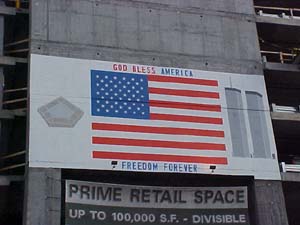 |
Underneath
the humor, as always in The Onion, is the very
core of the issue; nobody knows when to take down their
flags, because there was no official directive that told
everyone that they should have gone up in the first place.
It just happened, a spontaneous outpouring of grief, pride,
solidarity and defiance. So many people, in the aftermath
of Sept. 11th, asked what they could do. Among so many
daily newspapers, The Chicago Sun-Times responded
by adding, "FLY THE FLAG," in small capital
letters next to a flag and the paper’s title.
I didn’t see any of these things, being in Europe
from the beginning of September until the end of December.
I watched CNN that first week, read countless articles
online the weeks and months thereafter. Repeatedly, people
in the United States wrote to me that I had no idea what
it was like at home, it was a feeling they couldn’t
explain, that the country I left was not the one I would
return to. While I didn’t doubt this, I felt that
I was getting a fair idea of what it was like here, but
I now see that I had no idea at all. As a friend put it
to me the other day, "I think what you missed was
really seeing what it meant to have the country just completely
shut down."
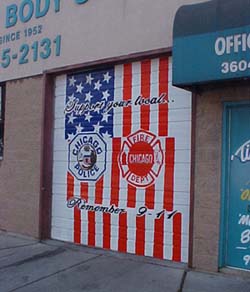 |
The
second and third weeks of September in Paris were a time
of mourning as well—an outpouring of flowers and
messages and memorials at the American Embassy, the American
Church of Paris and other places. Some of this came from
Americans living in Paris, but most was an outpouring
from French people. And the perspective remained that
way; a horrible thing happened, but over there.
It was an attack on democratic nations in general, but
despite many people from other nations being among the
casualties, it was the United States, its citizens, its
firefighters that died. And the country responded in kind.
In my ride home from O’Hare airport on December 21st
for an extended visit, I asked if there had been a resurgence
in the number of flags out, perhaps for the holidays.
I simply couldn’t believe that all of these cars,
homes, restaurants and businesses with flags and other
patriotic memorabilia had remained this way. I was told
that what I saw was a fraction of what had been displayed
in September and October.
Last
week on a drive between Chicago and Louisville, Kentucky,
I saw a billboard that read in large letters, "United
We Stand" on a white background. In the lower corner
was the logo for Stuckey’s restaurant, and directions
to the nearby location. This struck me as a bit offensive,
such an overt act of capitalizing on patriotism for the
sake of financial gain. AT&T Wireless has the same
sorts of ads, though the Stuckey’s seemed an even
more egregious example since it actually leads you to
the place of business. It is interesting to note that
these along with so many others are violating the Flag
Code (U.S. Code, Title 4, Chapter 1, Section 8, line (i)
which begins by stating that, "The flag should never
be used for advertising purposes in any manner whatsoever."
[The full code can be found at http://www4.law.cornell.edu/uscode/4/8.html].
I point this out mainly to comment on how much the rules
have been changed unofficially in the last few months,
including the display of flags in the dark without proper
illumination—which many homes are doing. And yet
this part seems right to me, that emotion should trump
formality.
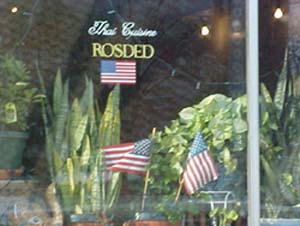 |
Out
for a drink with friends a week ago, the discussion turned
to this subject, and a married couple praised the Chicago
daily newspapers for printing up paper flags. Because
the stores had sold out, they gave people flags to display
in their windows, particularly those in this couple’s
heavily Pakistani neighborhood. My friends, both WASP,
likened it to the lamb’s blood that the Israelites
painted on their doors in the story of Passover, so that
the Angel of Death would know which houses to pass over
and not kill the first born inside. To my knowledge there
was no violence against anyone in this neighborhood, but
in this instance it was directly a way for these people
to demonstrate their devotion to this country. For them,
particularly those from the Middle East, this entire discussion
is a different one.
The ubiquity of flags has always made me, like many, a
bit uneasy. It has been difficult to separate patriotism
from jingoism. The Red Scare and the rebellions of the
late-60s only cemented this for future generations, giving
the flag and the Pledge of Allegiance a sense of something
almost un-American in its demand for devotion. Within
my own lifetime, the über-patriotism employed by
Ronald Reagan (leading to his re-election campaign’s
misunderstanding and misuse of Springsteen’s raging
song of protest, "Born in the USA") through
that of the first President Bush’s Gulf War, and
at times even Clinton’s teary-eyed pride had the
same effect. A common sentiment I have heard in the last
few months from friends on the left has been how suddenly,
it is okay to fly a flag. They can’t believe that
they themselves are doing it, a form of liberal culture
shock from former hippies to the youth on campuses today.
For lefties, this is the corollary effect of the recent
events; just as the Gulf War helped the military purge
the ghosts of Vietnam, this war, this "just war,"
is allowing us all to be patriotic on our sleeves and
not necessarily bring with it the bad connotations. The
flag has been taken back as a symbol of unity of all people,
not just those who support the particular administration
in office or its policies.
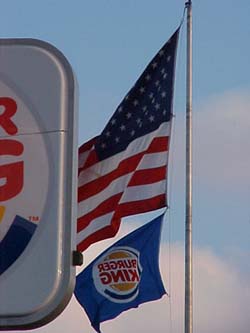 |
Explaining
this to French friends has resulted in a bit of a culture
clash. Even when France has experienced terrorism, it
has been responded to with a gamut of emotions from anger
to solemnity, but not, according to those I spoke with,
a display of flags. France is not a flag culture; certainly
there are French flags on government buildings, schools
and sports stadiums, but individuals do not own them,
they are not used in fashion or album covers and there
are no songs or holidays for the flags. There is no constitutional
amendment about burning the flag, because they just don’t
do it over there—it isn’t packed with the symbolism
that ours is to the rest of the world and as a statement
of domestic or foreign policies. Primarily, I would think,
this is because France does not have the same role that
the U.S. does in the world. Their blue, white and red
flag is simply Liberté, Egalité
and Fraternité. Unless, of course, we are
talking about sporting events. And therein lies the difference;
the World Cup, for example, is a contest between nations,
and it makes sense to demonstrate one’s "nation-spirit"
in contrast to another nation. That is why the saturation
of flags and stickers and signs saying "Proud to
be An American" seems a bit absurd to people in other
countries. They are asking themselves who we are trying
to prove it all to, as if the U.S. either has a chip on
our collective shoulder or are a bit too insecure and
have something to prove. A bit of "methinks the lady
doth protest too much."
After
a couple of weeks here, as I reached the point of saturation,
after all the ads telling us our civic duty is to spend
money, that phrase in the Chicago Sun Times, "Fly
the Flag" seemed less a suggestion to bewildered
and confused citizens in the immediate days after the
attacks, and began to take on an air more of an admonition,
a command. If it was all a spontaneous outpouring, it
doesn’t need directives, nor do businesses need to
accumulate more patriotic insignias to prove their dedication
to the nation, an ersatz form of "keeping up with
the joneses."
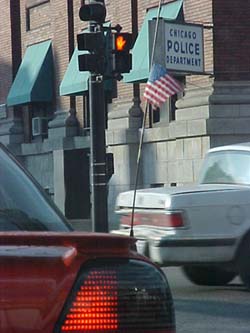 |
And
yet, despite my misgivings about all this, all the discussions
I’ve had about, it did get to me on that same drive
between Chicago and Louisville. A long flag flapped from
a stick, at the base of a driveway near a group of mobile
homes off the highway, where there wasn’t another
flag for miles. It didn’t lose its power because
of overexposure. It wasn’t put up by a corporate
power trying to push a product. It was just a family feeling
a sense of unity with their countrymen and wanting to
show it. If it hadn’t been there I wouldn’t
think they were any less patriotic. When I saw that flag,
all the issues of jingoism fell away. It was tattered
and solitary and just plain humble, and its image stays
with me.
|